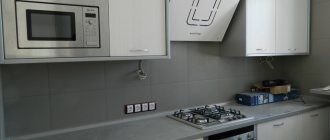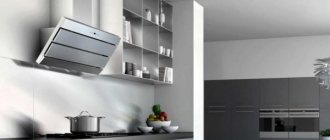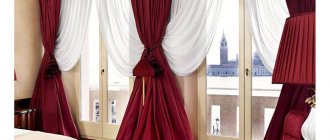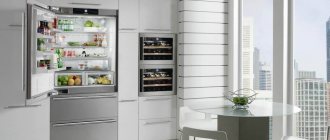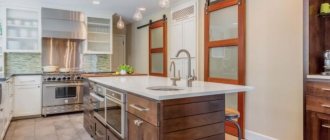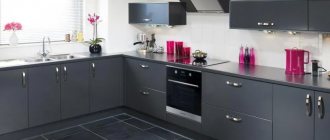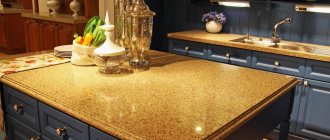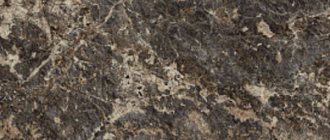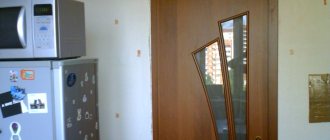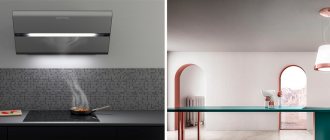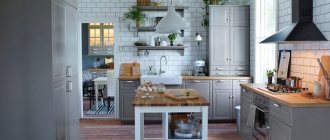A fireplace hood for the kitchen is a special mechanism for purifying the air from grease, smoke and odors of cooked food. Its shape and design give the product its name, since the device looks like a fireplace. Structurally, the fireplace hood includes the following parts: control unit, lighting system, filters. The control unit can be mechanical (usually buttons) or touch. The lighting system can use neon, halogen or LED lamps. The filtration system is based on the use of two types of filters: catching and absorbing. The catch filter is an aluminum or steel frame for depositing fat on it. An absorbent filter is usually made of activated carbon and is used to reduce dirt buildup and filter odors. Some models combine both filters or have the design option of adding a carbon filter to the catch filter.
Fireplace hoods
Kitchen fireplace hoods are a wide range of devices for air purification, ventilation and protection from greasy deposits in the kitchen. In the lines of global manufacturers of household appliances, dome hoods are presented in a variety of configurations with a practical set of functions.
How to choose a fireplace hood
The main criterion for choosing a fireplace (dome) hood for the kitchen is its performance, which allows you to determine in what volume a room will be effective. Devices with high performance better capture fat and absorb odors during cooking, so experts recommend paying special attention to this parameter.
Depending on the model, the hood may have one or several stages of filtration: even budget appliances have removable grease filters, and highly efficient carbon filtration is provided in mid- and premium-class models. Depending on your preferences, you can buy a dome hood with a push-button or touch control panel, made in a modern or classic style that harmonizes with the interior of your kitchen.
Control
Many people are interested in the issue of controlling a fireplace hood. There are several types of control mechanism:
- Push-button control. This is the traditional and therefore the most common option. There are buttons on the body of the device with which you can adjust the operation of the device.
- Touch control. Another fairly common type of control. However, it is not convenient for everyone, since the buttons do not always respond well to touch and it is difficult to press them blindly. Also, devices with this control method are highly susceptible to voltage surges.
- Slider (slider type). This type is considered not very convenient, since the controls are located at the bottom of the hood. In addition, they often become dirty.
USEFUL INFORMATION: Technical characteristics of Fugenfüller Knauf putty
Recently, many models come with a remote control included. This is really convenient, since you can control the hood remotely, and in addition, there are no fingerprints left on the shiny surface.
Practical purpose
A fireplace hood is, first and foremost, safety.
Fireplace hoods provide:
- optimal air composition in the room where the fireplace is installed;
- elimination of condensate formed during the combustion process;
- removal of harmful substances formed during the combustion process.
The hood is installed when the fireplace is created or when the room is being renovated. With this approach to the event, it is easiest to hide structural inconsistencies, if any.
Important! When installing an exhaust system for a gas fireplace, the creation of a chimney is mandatory. But, since the operation of such a fireplace is not accompanied by the formation of soot, narrower chimney designs with two turns can be used.
To create draft when installing a chimney with turns more than 2 times, it is necessary to install a forced ventilation system.
Noise level
The more powerful the hood, the louder it will be. The same applies to the operating mode. It is not very pleasant to cook or eat in a room where the hood is constantly making noise, drowning out the voices of family members.
There is a dependence: the more powerful the hood, the higher its price. The same goes for the noise level. Quieter (but no less powerful) models are much more expensive than noisy ones.
The standard hood noise level is 40 dB. This indicator can be reduced or increased when changing the operating mode.
Advantages of fireplace hoods
A design of this type has a number of advantages: it prevents furniture and walls from being finished, eliminates unpleasant odors, and also promotes the flow of fresh air. And these are not all the advantages.
The cost of dome hoods varies depending on the size, performance and material of manufacture. The price range is huge, so it’s easy to choose a model that suits your taste and budget
Appearance
The design of fireplace hoods is stylish and creative. The aesthetic appearance does not require additional decoration. They look organically in any kitchen interior, and the variety of models, materials and colors opens up a wide choice for the buyer.
A wide range of fireplace hoods allows you to choose a model for the kitchen interior in any style - from classic to high-tech
Thanks to the dome-shaped shape, there is no need to mask the ventilation communication.
Some hoods of this type are used as a continuation of the kitchen unit in the form of a shelf.
Corner fireplace hood with shelf for souvenirs
Dome shape
One of the features of the fireplace hood is the volumetric body, which has the shape of a trapezoid or hemisphere. Due to the dome shape, space is created for installing several filters and a powerful fan at the same time. This increases the performance of the device and the ability to purify air in large kitchens. It is also worth noting the ease of installation; installation can be completed without the help of specialists.
Dome hoods belong to the class of flow-through ventilation systems with high power and performance
A fireplace hood is characterized by high performance and functionality, regardless of the size and cost of the device. Some models have built-in reusable filters and two engines at once, improving the quality of air purification.
Other important properties to choose
Other features that may be important when choosing a hood are backlight, number of speeds, timer, monitor accessibility, control type, etc.
It is very convenient if the equipment is equipped with a backlight - this will allow you to control the cooking process and not miss the moment of combustion.
The presence of several speeds allows you to adjust the intensity of the hood depending on the pollution of the atmosphere. The timer allows you to automatically turn off the device at a certain time. The choice of control type is justified by practicality of use: some prefer a touch option, others prefer a push-button, lever or rotary control mechanism.
Operating principle
The complexity of the work depends on the operating principle. Circulating hoods operate without being connected to an air duct; the air is purified by a built-in filter system and returned to the kitchen. The installation of a flow-type dome hood looks more complicated. Its installation will require connection to the air outlet shaft, but it cleans the air better than the previous type. Some models have a combined design and can operate in both modes, at the user's request.
Functional capabilities
A kitchen set with an inclined type hood has an unusual and elegant appearance. This is facilitated by high-quality and economical LED lighting, ergonomic shape, as well as the capabilities of the device. The functionality of the equipment is an important factor when choosing, and various models, in addition to convenient touch control, demonstrate the following capabilities:
- Automation of the start of work: automatic switching on and off, delayed start, timer.
Compact location Source onliner.by
- Special software monitors the condition of the filters and signals the need to replace them.
In a country kitchen Source homevalley.ru
Cleaning performance
In this case, these are volumes of air that the equipment can clean per unit of time. To determine what the level of productivity should be, it is necessary to calculate the product of the volume of the kitchen and the air exchange rate. As a quantitative indicator of the last parameter, it is recommended to use the average level of air exchange per minute equal to 12. It should be taken into account that the cleaning efficiency is affected by the number of elbows of the ventilation duct and the rate of filling the room with harmful substances. It is known that one bend in 90 means a loss of 10%, and the filling rate of small rooms is higher than that of larger ones. Therefore, productivity should be selected with a reserve.
Dimensions
There is no point in installing an air purifier with a socket size smaller than the area of the hob. It will not be able to capture the entire volume of vapor, a significant part of which will remain in the room.
The ideal option is the ratio when the air intake area is slightly larger than the area of the cooking surface of the stove.
Manufacturers offer models with different parameters, the most common being 50 and 60 centimeters in width, which correspond to the standard sizes of most gas and electric stoves.
Dimensions
A fireplace hood for a kitchen should fit the dimensions of the stove, that is, their dimensions should match as much as possible. The air purifier can be wider than the stove. This will capture all air flow contaminated with harmful substances.
The most optimal ratio is considered to be the option in which the dimensions of the hood are slightly larger than the dimensions of the hob.
The most common devices are air purifiers with a width of 50 and 60 cm. There are also other sizes of hoods: for example, 90 cm.
What criteria to consider when choosing a fireplace hood
The statement that the larger the hood, the better its power qualities, does not apply in the case of a fireplace design. This type of equipment is a priori produced in small sizes, which makes its use rational only in small areas. Therefore, for spacious kitchens you should choose some other option.
Power
To check whether the selected hood model is suitable for this parameter in your kitchen, you need to multiply the area of the room by 12. But you don’t have to do mathematical calculations. A consultation with a sales manager will be enough - he will be happy to provide you with the necessary information.
For small kitchens (<11 m²), accepted standards regulate the installation of products with a capacity volume of 350 m³. For medium-sized rooms (11-18 m²), a device for 350-420 m³ is suitable. For spacious kitchens, the best solution would be a unit of 600-650 m³.
Noise during operation
It is worth remembering that this characteristic depends on the power - the more powerful the hood, the more noise it will make during operation. The constant presence of hum is unlikely to make cooking a pleasant experience. In addition, loud sounds will make it difficult to communicate with household members. As a result, when choosing a hood, experts recommend focusing on models with the ability to adjust the noise level.
Filter system type
The difference between the hoods presented in the store often lies in the type of filters. Some models are equipped with an external filter to retain grease particles and combustion products, as well as an internal one to clean the air from unpleasant odors. Other devices also have a special grease-repellent filter system that requires virtually no cleaning. This, of course, is reflected in the price.
When purchasing an economy class model, the user must be prepared for the fact that after a couple of months the filters will have to be cleaned. Owners of more expensive devices are spared this tedious task. If the filter system of elite units needs cleaning, it will not be soon.
Reference! If there are still unwanted aromas in the air when the hood is running, this means that the filters are dirty and require replacement.
Material of manufacture
An important criterion when choosing a fireplace hood is the material used for manufacturing. The higher its strength properties, the longer the unit will last. Fireplace ventilation is most often made of metal. But there are also plastic, glass and wooden options.
Which technique should you prefer? It depends on individual preferences and financial capabilities. We hope that the information in this article will help you make the right choice.
Rating of the best models
PERFELLI TL 6102 i
This is a telescopic hood built into a wall cabinet from the ORZO design line, made in Poland. The device weighs 7 kg, has a steel color and a retractable panel. Productivity is 550 cubic meters per hour with a power of 150 watts. The device is equipped with a push-button control, and a filter is installed to retain fat. There is a design option to install a carbon absorption filter. Simplicity of design is combined with compact size and inexpensive price. The hood is easy to use and well lit. Among the shortcomings, only two engine operating speeds can be noted, with a high noise level on the second.
The average cost of the unit is 4000 rubles.
HANSA OWC 4778 IH
This is an island type fireplace hood with a cylindrical shape. It can work for air removal and circulation. The product is made in Germany. The hood is equipped with touch control with additional options: automatic shutdown using an odor sensor, timer, degree of filter contamination. The stylish steel-colored product consumes 280 watts with a capacity of 900 cubic meters. at one o'clock. The reusable steel filter can even be washed in the dishwasher. A plus is the presence of three engine speeds.
Among the disadvantages, there is an increased noise level of 53 decibels and a high cost of about 40,000 rubles.
PYRAMIDA WH 22–60
This stainless steel colored hanging hood is made in China. The model operates on exhaust/circulation with a power consumption of 120 W. The product is equipped with mechanical push-button control. There is a filter to catch grease, but it is possible to additionally install a carbon filter. Despite its apparent simplicity, the hood does an excellent job of cleaning the air. Disadvantages include a glass visor, which is difficult to clean when dirty, and poor lighting. Average cost 4500 rub. This material will tell you how to choose a professional pancake maker for your kitchen.
BOSCH DHL 545 S
The German-made, steel-colored built-in hood is equipped with two halogen lamps. The product is equipped with a mechanical control and includes a filter to catch grease. The filter is easy to remove and clean. The hood operates for exhaust/circulation, consuming a power of 380 W. and productivity 500 cubic meters per hour. A nice powerful model with a very low noise level. Among the disadvantages, one can note the high price of the product.
The average cost of the product is 85,000 rubles.
ELEYUS LANA 700 60 BL
Fireplace wall hood made in Ukraine. The device is equipped with mechanical push-button control. The product operates on air removal/circulation, consuming a power of 220 watts. The device has halogen lighting and combines glass and metal. The hood is equipped with an aluminum filter to trap grease. The simplicity of the design is accompanied by effective air purification work and a capacity of 750 cubic meters. at one o'clock. Excellent balance between price and quality. The device weighs 12 kg, which makes it difficult to install independently. Find out about kitchen scales here.
Average cost 5000 rub.
Classification of fireplace umbrellas
Based on how a fireplace hood works, there are 2 types of devices: flow-through and circulation. Ventilation of the first type removes gases from the room directly to the street, providing high efficiency of ventilation and air purification. This method is the most popular; when it is executed, the hood is connected to the general ventilation system of the house, but it is possible to route the pipes directly outside.
The circulation hood functions by filtering gases and does not require integration into the building ventilation scheme. The purified air is not removed outside, but returned to the room. The quality of the microclimate with this approach is determined by the frequency of replacement of filter elements and the correct selection of products based on performance.
Many companies are engaged in the manufacture of ventilation devices. They offer umbrella hoods with various functional equipment. Based on the type of construction, the division into models is known:
- Wall-mounted, when the dome is mounted above the hob, which is why this name appeared. The scheme is widespread, represented by effective devices of good quality and reasonable price. An example is Best Delta S1 A2 PU A/F60 XS, VENTOLUX Capri 50 WH.
- Island - they are chosen if the stove is located in the center of the room. This option is usually preferred in private houses - there it is easier to install a separate ventilation duct for the outgoing smoke. A pipe is installed in the apartment from the umbrella to the ventilation shaft. An example is the Bosch DIB 091U52 hood.
- Corner models are rare due to their complex configuration. Suitable for small kitchens, where every centimeter of free space is taken into account. The casing design is straight or sloped.
- Built-in hoods - the role of the housing is performed by the wall cabinet of the kitchen unit; the ventilation pipe is hidden in it. This type of design cannot truly be called a fireplace design.
- Inclined - a type of wall models. They differ from the horizontal arrangement in a modern design solution; the cost of such a product is higher. Sample - PYRAMIDA KZ 60 BL.
The technical part of exhaust devices depends on the area of the room, the type of stove for cooking and the frequency of cooking. The standard umbrella width is 0.6 m, which corresponds to the size of the hob. Models with a body of 0.5 and 0.9 meters are often produced.
Popular manufacturers
Fireplace hoods are produced by almost all companies that manufacture kitchen appliances. The most popular of them are:
- Bosch, Siemens, Kuppersberg, Backer (Germany);
- BEST, Zanussi, JetAir, Elica (Italy);
- Cata (Spain);
- ELIKOR, “Hephaestus” (Russia);
- Gorenje (Slovenia);
- "Pyramid" (Ukraine-China).
Pros and cons of hoods with carbon filters
You have already noted one of the advantages of charcoal hoods for the kitchen: polluted air is not removed from the room, but is purified, so this equipment can guarantee you greater safety compared to other models.
To dispel all the myths about the quality of work of carbon filter systems, we invite you to familiarize yourself with other advantages of this technology:
One of the main features is compactness and ease of installation due to the small dimensions of coal hoods. Such equipment will not only become an assistant in everyday life, but will also help emphasize the harmony of the interior and the exquisite taste of the hostess.
You no longer have to look for ways to disguise air ducts or plan the placement of furniture with maximum convenience for installing exhaust devices. Since this type of hood does not block the ventilation duct, the room will maintain natural circulation of clean air: this is especially important if you are used to gathering in the kitchen with the whole family. Unlike most hoods, coal models do not require additional air supply for full operation.
The cost of such equipment, despite the quality and functionality, remains low due to savings on materials. Many believe that periodic purchase of filters will cost more: even when purchasing a high-power hood, the overall savings will allow you to stock up on filters for 10 years. Unlike hoods with an air vent, which must be attached to the ventilation shaft, coal models can be placed absolutely anywhere in the kitchen, providing only access to the power grid. Another significant advantage of installing such equipment is the ability to be built into kitchen furniture
You get not only a stylish, but also an ergonomic design of the work area.
Hoods of this type are universal. This means that you don't have to guess how to match the hood to the style of the kitchen or its colors.
All charcoal hoods have a simple and laconic design, which, by the way, is ideal for even the smallest kitchens.
When searching for a suitable model, you will be able to note the variety of sizes of such equipment.
There is an opinion that the use of carbon hoods is inconvenient due to the need to search for special filters strictly from the manufacturer. In fact, almost any type of carbon filter has analogues, and many of them are characterized by superior quality.
If you doubt the better performance of hoods with a recirculating cleaning mode, then you may also be mistaken, since their effectiveness will depend on the power, and not on the cleaning features. In addition, the beneficial effect will depend on the frequency of filter changes and on proper care of the equipment.
Tip: to purchase the right model, study the data sheet: it indicates for which rooms the available power is sufficient. You can calculate the required productivity yourself: multiply the room volume by 12 and 1.3.
Of course, even the highest quality hood of this type will not be able to clean the air 100% of unpleasant odors. However, with a filter cleaning system in place, it will be easier to achieve maximum comfort. Another bonus is the solution to the problem of all odors reaching the neighbors through the ventilation duct.
The only negative that may affect your final choice is the high energy consumption. However, hoods with carbon filters do not affect the temperature of the kitchen during operation, unlike models with open ventilation that allow hot or cold air to enter from the street.
You don't have to turn on the air conditioner or heaters to restore the microclimate in the room - and this is also a significant advantage.
Configuration
The first thing you should pay attention to is the shape and principle of air filtration. There are 3 types in total.
Hanging hood
Flat or sloped design is installed directly above the stove on the wall or under the kitchen cabinet.
| Professionals | Against |
| Takes up little space | Most often they work without an air duct, using acrylic filters that need to be changed periodically |
| Easy to install on any part of the wall | Most models are equipped with low-power motors, so they only allow a small amount of air to pass through at a time. |
| Affordable price | Not particularly suitable for large spaces |
| Easy to maintain, repairs are quite simple if necessary | Noise levels may be high |
Experts recommend buying them for small kitchens, for example, in Khrushchev-era apartment buildings.
Built-in hood
The main difference from the previous type is the presence of a special drawer or cabinet.
| Professionals | Against |
| You can find a budget model | You need to allocate space in the headset |
| Many configuration options: from a thin pull-out panel to a powerful professional hood | It will cost more hanging |
| Low noise level | |
| Effective in large spaces | |
| Some have a separate space for air ducts |
According to reviews, this is the most popular type. A large selection of models, many additional options... By the way, here is a good buyer's guide on how to choose the right built-in hood.
Dome or fireplace
They owe their name to their shape, reminiscent of a traditional hood for antique fireplaces. True, now they are completely different - many fit more modern design styles.
| Professionals | Against |
| They do not purify the air, but remove polluted air from an apartment or house | High price |
| It can quickly purify the air in a large kitchen | Complex work on installation of air duct and drainage |
| Looks interesting | Takes up a lot of space |
| There are corner options suitable for non-standard kitchens |
As you can see, this is a powerful unit that is irrational to consider for small kitchens. But for a studio apartment this is ideal - it is almost impossible for odors to penetrate into the living area.
Island hood
Not so long ago, this species was encountered exclusively in foreign restaurants or films. Nowadays, large drainage units located in the center of the room are not uncommon in ordinary apartments.
| Professionals | Against |
| High-quality air purification over a large area; | Size: not suitable for small kitchens; |
| Elegant and unusual appearance; | High price; |
| Possibility of installation anywhere, not just against the wall; | Noise level. |
| Extensive functionality; |
Read more: How are kitchen countertops secured?
If these shortcomings do not bother you when purchasing an island hood for air purification in the kitchen, you will receive a reliable and powerful unit.
T-shaped hood
They got their name from their shape: upside down, the appliance resembles the letter T. These are classic hanging hoods that, depending on their characteristics, adapt to almost any kitchen.
Decorative hood
It is difficult to give an unambiguous definition here. It could be an inclined or T-shaped device, or it could be a non-standard gadget. They are loved for their decoration and unusual appearance - most often such units look very stylish.
Which to choose? You decide. Consider the area of the room, the frequency of cooking, and the presence of ventilation in the house. Doubt? Visit specialized forums where housewives share reviews of real models.
The next important aspect is the operating principle of the hood.
Installation
Installing a fireplace hood in the kitchen with your own hands is a task that a home craftsman can handle. The main thing is to choose the right device and carefully read the instructions. A good manufacturer should highlight the conditions and parameters necessary for installing a specific wall-mounted hood. They must match the size of the kitchen space. Otherwise, the product will not be able to be installed correctly, which means its operation will not be correct. For example, the wall-mounted kitchen hood LC958WA60 is fixed at a height of 55 cm from an electric stove and 65 cm from a gas stove. And the White Storm 60 air purifier is mounted 10 cm higher in both cases.
The front panel is made of glass
It is precisely such nuances that you need to pay attention to. If you hang the hood above or below the established requirements, it will either burn out or be useless.
The installation of an air vent has its own nuances:
- A sealed throttle valve is installed on the air channel. When the wall hood is not in use, this passage is closed, preventing warm air from leaving the room.
- A grille is placed on the entrance niche.
- You should not run a duct from the basement, as an unpleasant odor may emanate from there.
- It is recommended to install the air vent on the windy side. Air currents will discharge the channel space and draw out all unpleasant odors.
Properly arranged ventilation guarantees good functioning of the hood. The temperature of the air leaving the device should not exceed 80 degrees. If installed incorrectly and with poor ventilation, the level can rise to 180 degrees, which will lead to overheating of the housing and a fire hazard.
To install a fireplace hood in the kitchen you will need several tools:
- Screwdriver;
- Electric hammer drill;
- Durable tape measure;
- Building level;
- Fastenings (screws and dowels);
- 2 hammers with different sizes.
How a kitchen hood works
Installation sequence
The dome hood is secured in several steps:
- Determine the exact boundaries of the location of the device from the source.
- Use a pencil or marker to mark the location where the hood will be installed.
- Mark the fixation points for the screws.
- Using drill number 8, make holes for screws with a depth of at least 5 cm.
- Fix the dowels in them.
- Carefully screw the screws into the 2 upper dowels and install the hood on them.
- Check the quality of fixation.
- Drive the remaining screws through the back panel.
Service
The service life of an air purifier depends on the care of the device. The main thing you need to monitor is the condition of the filter elements, which are divided into three types:
- Disposable padding polyester. Made from paper or non-woven fabric. Such filters have special marks that are clearly visible through the protective grille. Their disappearance indicates the need to replace the grease trap.
- Reusable acrylic. They are washed monthly in soapy water without squeezing too hard.
- Reusable aluminum. Once every 30 days, clean with a degreaser or wash in the dishwasher separately from cutlery.
Purified air in the kitchen from combustion products and unpleasant odors
Filter quality control is necessary not only to increase the performance of the device. Concentrated grease may cause the element to catch fire, so periodic cleaning is required to ensure fire safety.
You need to take care of your kitchen hood regularly. This will extend the service life and get a high cleaning result. Caring for the device consists of several stages. First, the hood is disconnected from the power supply. Then disconnect the grease-absorbing filters and wash all accessible parts. It is not recommended to use abrasives, sponges or scourers with hard cloths. The buttons on the control panel are wiped with a damp cloth. The last step is to wipe all the elements dry with a napkin and connect the hood to the power source.
Air filtration devices
A filter device made of metal mesh or special perforated foil can be used repeatedly if washed regularly. The operating period of such a filter can be very long.
The thickness of the mesh, as well as the shape of the perforated holes in the foil itself, is determined taking into account the largest contact area and the noise generated by the passage of air flows.
In many hoods, the filters can be cleaned by placing them in the dishwasher.
In this case, relatively light household chemicals are used. Hardened accumulated fat is very difficult to remove with ordinary detergents.
The synthetic filtration device is considered disposable and therefore must be replaced when dirty. The hood will operate silently with such a filter, thanks to the artificial felt layer. Synthetic filters are much more convenient to use compared to metal devices. However, each time you replace you need to pay money for a new device.
Carbon filtration systems are manufactured using specially developed technology. The fine filter is a separate container filled with activated carbon, which can be mixed with additional disinfecting components.
These components include:
- silver;
- ion exchange resins;
- cation exchangers.
The frequency of replacement of such filters is determined by the intensity of operation of the device and the degree of contamination of the filtered air mass. It is recommended to replace the carbon filter once every 4 months. If you use such a filter longer, over time it will begin to pollute the air even more. Compared to grease removal devices, carbon filters are much more expensive.
- The air is easily purified from unpleasant odors spreading throughout the kitchen.
- Fuel combustion products do not spread throughout the living space.
- A fairly powerful device can even catch splashes of grease.
- The humidity level in the kitchen is significantly reduced.
- The room is filled with fresh, cooler air.
Hoods can purify the air throughout the entire apartment, so it is advisable to leave the doors to each room open.
Fan - advantages and disadvantages
An exhaust fan can speed up the air flow 3-7 times. At the same time, the volume of gases removed per unit of time increases by the same amount.
Besides:
- the active system allows you to increase traction simply and at minimal cost;
- The hood parameters do not depend on the weather. Does not affect the hood and indoor temperature;
- conditions for reverse thrust are excluded;
- it becomes possible to regulate the rate of smoke removal depending on the operating mode of gas and furnace equipment. When the heater power decreases, the fan speed is reduced.
To remove smoke, a smaller cross-section of air ducts is required due to rapid air movement. This means that an active chimney requires less material during manufacture.
A modern chimney fan is protected from rain and leaves. It is installed on the pipe using special fasteners
But there are also disadvantages:
- the fan consumes energy. Due to this, the operating costs of the heating system increase;
- You need to run a cable to the motor. This is not so easy to do. The active hood is placed on a pipe, and it is not advisable to make holes for the wire in the roof;
- It is necessary to provide measures to protect the impellers from precipitation and icing.
The listed disadvantages must be taken into account when moving to active smoke removal. Then the disadvantages can be neutralized.
Taking into account the positive properties of active exhaust hood, the smoke exhauster is installed on the chimneys of modern cottages, in houses, when installing fireplaces using wood or briquettes.
Requirements for the exhaust device
Not every engine with an impeller is suitable for working with carbon monoxide.
The smoke exhauster must be:
- Heat resistant. It must be taken into account that when a stove or fireplace is operating, the smoke heats up much more than in the column. The temperature of gases from the fireplace at the outlet of the chimney can reach 300 °C or more.
- Resistant to aggressive gases.
- Economical. When there is wind, the electric motor turns off. The impeller spins as in a rotary turbine.
- Water resistant. Weather conditions should not interfere with smoke removal.
- Effective. The fan must ensure rapid removal of furnace gases at any indoor and outdoor temperatures.
A duct fan for removing smoke is built into the air duct. But more often they use a smoke exhauster installed on a pipe.
The high-temperature duct fan must operate in an aggressive environment. Therefore, it is made from smoke-resistant materials
Do not confuse a chimney fan with a forced draft fan in a fireplace. The latter is designed to ignite and maintain combustion in the firebox. While the boost fan is cut into the chimney, or a smoke exhauster is installed on the pipe. Modern devices for active removal of furnace gases can withstand temperatures up to 600 °C.
An active smoke removal device monitors the temperature of gases and their speed using sensors. The data is used to control the engine and ensure the safe operation of the fireplace, stove and gas equipment.
Installation of a fan in a chimney
Before installing the fan on the pipe, you need to carry out a number of preparatory work. The first step is to ensure safe working at height.
To do this, a special ladder is installed on the roof next to the pipe with the possibility of attaching safety elements
Next, mark the places on the pipe for attaching the smoke exhauster, and run a cable to power the engine. Lay signal wires from gas equipment controllers and other energy devices.
At the following stages:
- Mount the fan assembly, eliminate the gaps, and check the tightness of the connections.
- Connect the power cable, connect the sensors to the wires.
- Apply power voltage and start the smoke exhauster.
- Using measuring instruments, check the parameters of the carbon monoxide removal system.
- The installation work is completed and the fixtures are removed from the roof.
- Sensors are connected to power plant control systems.
- They turn on gas equipment, stoves, fireplaces and check the effectiveness of smoke removal again.
To operate a top-mounted smoke exhauster, cables and wires are routed through the roof. This is not always convenient. If you do not need to install a product with the function of a rotary turbine, buy a high-temperature duct fan to remove furnace gases.
Install the device as far as possible from the place where the exhaust air is heated. The installation algorithm for a duct smoke exhauster does not differ from that discussed above.
Preparing for installation
For classic dome hoods, an exit to the ventilation duct and a connection to the electrical network should be provided. What are the features of connecting to a ventilation duct? If two separate systems are provided, then one of them will have to serve for natural ventilation of the premises, and the second should be used for forced installation.
If we are considering a private house, then it is better not to touch the vertical ventilation, but to provide a direct opening to the street for flow-through exhaust. A check valve device should be installed in the ventilation duct to prevent cold air from entering the house.
It is also necessary to place a grill on the inlet to protect from precipitation and insects. The ventilation system should be firmly fixed to the building structure and sheathed with soundproofing materials. As for connecting to the electrical network, dome structures are provided with a wire outlet for direct connection or a grounded socket.
Air duct for kitchen hood
The palette of air ducts used for kitchen exhaust systems differs greatly in three parameters:
- Material of manufacture.
- Form.
- Hardness level.
Products used to install hoods in the kitchen can be flexible (corrugated) or made of solid, smooth and hard plastic.
Exhaust pipes are made of several types of plastic:
- PVC;
- fluoroplastic;
- polypropylene;
- low-pressure polyethylene.
To connect to the hood, the first three types of plastics listed above are used: they are resistant to high temperatures and have decent rigidity.
Air ducts, in turn, have two types of sections:
- rectangular;
- round.
The rectangular plastic channel has a more compact size, it is easy to disguise it under a suspended ceiling, and it is more convenient to install.
The round shape of the pipes promotes better air passage and has a low noise level.
Air duct sizes for hoods
Do not forget that when buying a PVC air duct, you should also buy adapters . They are needed to connect the plastic tube to the hood. In addition, they are used for air duct bends and the possibility of attachment to the general ventilation system of the entire house. Therefore, if you decide to use corrugation, you can save on unnecessary adapters.
You should know! The length of the PVC pipe should not be more than three meters . Otherwise, the performance level of the exhaust system will decrease with each additional meter of its length. Each piece of bend also has a bad effect on the performance of the hood, so you should try to avoid ninety-degree angles . You can make no more than three bends and bending points .
The diameter of the plastic pipe should be selected strictly according to the cross-section of the ventilation hole:
- The size range of rectangular and square PVC air ducts has standard sizes. The most commonly used sizes are: 110 X 55, 120 X 60 and 204 X 60 mm;
- indicators of round plastic pipes: from 110 to 150 mm. (diameter).
How to attach corrugation to the hood and ventilation
If you intend to install a hood using an aluminum corrugated hose, then you need to decide on the method of attaching it to the body and to the ventilation. For this purpose, you need to purchase a clamp of the required size (there are metal and plastic).
In addition to the clamp, a special ventilation grill with a hole at the top for connecting the air duct tube is useful. At the bottom it has a hole to remove “dirty” air from the kitchen using natural circulation during the time the exhaust system is not functioning.
Note! To secure the corrugation, you need to use a grille with a protrusion: in this case, a small side surrounds the hole. It is on this that the corrugation is put on, and then it is secured with a clamp of the required size. The corrugation should also be secured to the hood: also using a protrusion.
How to attach an air duct to walls
Plastic air ducts have special fasteners in the form of a latch. They are first mounted into the wall using dowels. Most often, only one fastening is sufficient for an area of up to 60 cm. It is into these latches that pipes are inserted during installation, with little effort.
When you want to attach to the ceiling , use exactly the same fasteners. If it is necessary to maintain a certain distance from the ceiling, this type of fastening is not suitable. Then you will need to take perforated hangers (plasterboard), fix them to the ceiling, and then attach the PVC air duct to them with small screws.
The corrugated air duct should be secured to the wall using a clamp or plastic ties.
Where and how to remove the air duct
As a rule, the air exhaust system from the hood is carried out into the ventilation hole (this is where the natural process of general house ventilation takes place, and draft is present).
But this is not a competent approach, because a significant part of the grille turns out to be closed by the air duct, and a full exchange of air mass is not possible through the remaining tiny hole.
You should know! Installing a hood in the kitchen requires connecting the air duct to a separate channel dedicated to it.
- If there is a separate channel, the same grille as in the photo should be installed on the hole:
- When installing a hood in the kitchen on your own, if there is no separate channel, but there is an outer wall nearby, you will have the opportunity to route the pipe to the street side by placing a grille outside.
These are the two main methods of installing well-functioning ventilation with a long period of operation.
How to take it outside
First of all, in order to bring the air duct into the wall, you need to make a hole in the wall. It is the production of the hole that is the main difficulty of this work.
When the hole is ready, you need to insert the “body” of the air duct into it, and close the remaining gaps with a solution. From the outside, the hole must be covered with a grill (to prevent dirt, unnecessary objects, birds, etc. from getting into it).
To prevent street air from blowing into the apartment, it is necessary to install a check valve - in the figure below we have indicated it with a beveled line:
If you carefully examine the picture, you will notice that the non-return (non-return) valve is a light plate made of plastic or metal. It is fixedly fixed at two points to the pipe (top and bottom), and the “petals” are supported by a weak spring.
When the exhaust system is not working, the valve blocks the access of air masses from the street. As soon as the hood is turned on, the plate, thanks to a spring, returns to its place.
Remember! If you decide not to install a check valve, then in winter the kitchen will be very cold due to the icy outside air entering the apartment.
So that the hood does not interfere with natural ventilation in the kitchen
Using a regular tee and check valve, you can install the exhaust system in such a way that it cannot interfere with the natural ventilation of the kitchen area. To do this, it will help you:
- specialized ventilation grille;
- presence of a check valve;
- the presence of a regular tee.
How should this be installed? You must attach a tee to the ventilation grille: connect the air duct from the hood to its lower inlet, and install a check valve on the free outlet so that it closes when the air flow passes from the pipe, as shown in the picture:
Let's talk about how such a system functions.
When the hood is at rest, the “petals” of the valve are bent, and the air flow from the kitchen area enters the ventilation duct, passes through the grille and the open outlet of the tee.
As soon as the system is turned on, the air flow from the hood rotates the valve plate, and the air flow enters the ventilation system. When the hood is turned off, the springs again open the passage of air through the tee.
Take note! From the outside, such a system is not entirely attractive, and, of course, it should be disguised. But, it is the only way to connect the hood to the only existing ventilation outlet, while maintaining air exchange.
Step-by-step instruction
- The installation height of the hood is determined according to the manufacturer's recommendations. The marking is carried out directly on the wall - a horizontal line is drawn to the required height, the evenness of which is measured using a spirit level.
- The device height is set. If the indicators show that the hood is longer, the pipe is cut, since installing the hood below the required height is strictly prohibited.
- Measurements are being carried out to determine the mounting points on the wall. These points are attached to the wall.
- Based on the “beacons,” holes are drilled into which plugs are inserted.
- The hood is attached to the wall from above with self-tapping screws. Only after complete alignment is the hood completely fixed.
- The outlet pipe is connected to the chimney.
Important! Install a check valve at the outlet to prevent exhaust air from entering the room.
